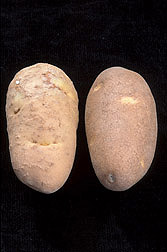This page has been archived and is being provided for reference purposes only. The page is no longer being updated, and therefore, links on the page may be invalid.
|
Read the magazine story to find out more. |
|
|
|
|
Pest-Resistant Potato on Tap
By Jan SuszkiwApril 17, 2009
A new russet potato germplasm line developed by Agricultural Research Service (ARS) scientists and collaborators could help cut the cost of using chemical fumigants to fight Columbia root-knot nematodes (CRN).
The wormlike pests are problematic in the Pacific Northwest, where two-thirds of America's potatoes are grown, as well as in Florida. Although fumigating the soil before planting time diminishes the pest's numbers, the practice isn't cheap, with some chemicals costing $300 per acre. Beneficial, soil-dwelling insects can also be harmed, according to geneticist Chuck Brown, with the ARS Vegetable and Forage Crops Research Unit in Prosser, Wash.
Thanks to genetic resistance, the new russet potato, PA99N82-4, offers a way to naturally protect the roots and tubers against nematode feeding. Putting that resistance to work hasn't been easy, though.
Brown and colleagues conducted painstaking screening of material from Solanum bulbocastanum and other wild species kept at the ARS U.S. Potato Genebank in Sturgeon Bay, Wis. Because wild and cultivated potatoes are chromosomally incompatible, the researchers resorted to bridging, a technique that fused S. bulbocastanum and domesticated potato cells together, which forced the DNA of both to combine. The cells were then stimulated to become plantlets. Later, "backcrossing" was used to eliminate unwanted traits (like tiny tubers and poor taste) from CRN-resistant plants that the researchers had created.
They also used DNA marker technology to identify plants harboring the S. bulbocastanum gene for resistance, namely RMc1(blb). Normally, resistance levels are determined by inoculating potted plants with nematodes, waiting seven weeks and removing and washing the roots so the pests' eggs can be counted. Use of DNA marker streamlines this process and identifies resistant plants in one day, according to Brown.
PA99N82-4 will undergo two more years of field-testing before it is released for use in developing commercial varieties.
Read more about the research in the April 2009 issue of Agricultural Research magazine.
ARS is the principal intramural scientific research agency of the U.S. Department of Agriculture.

